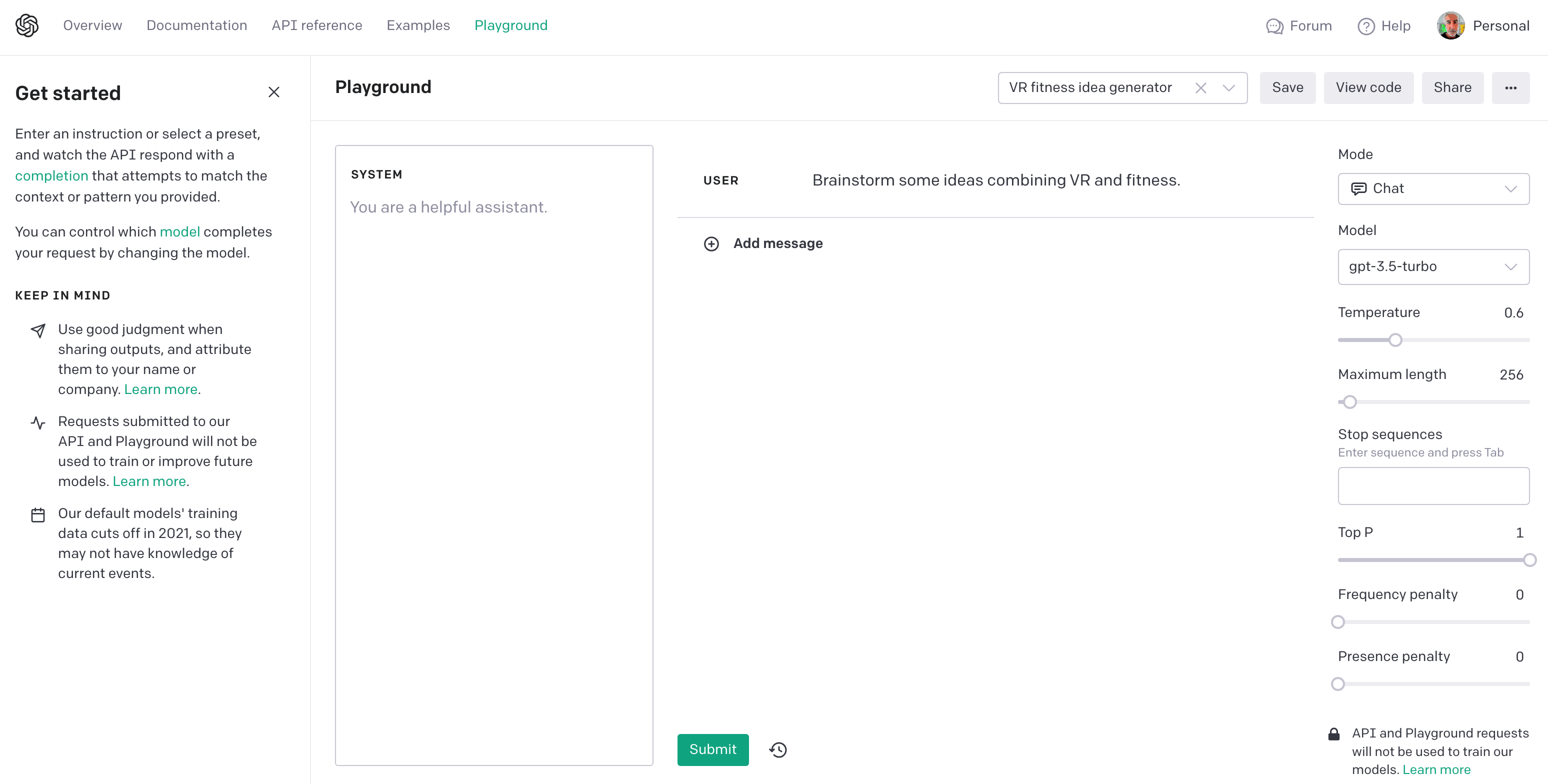Generate ideas for fitness promoting virtual reality games.
curl --location --request PUT 'https://api.openai.lawrencemcdaniel.com/examples/default-vr-fitness' \
--header 'x-api-key: YOUR-API-GATEWAY-KEY' \
--header 'Content-Type: application/json' \
--data '{"Brainstorm some ideas combining VR and fitness."}'{
"isBase64Encoded": false,
"statusCode": 200,
"headers": {
"Content-Type": "application/json"
},
"body": {
"id": "chatcmpl-7yU1gfYWXwpPfIqqAMqJlf4WvfsWQ",
"object": "chat.completion",
"created": 1694649456,
"model": "gpt-3.5-turbo-0613",
"choices": [
{
"index": 0,
"message": {
"role": "assistant",
"content": "1. Virtual fitness classes: Users can join live or pre-recorded fitness classes in a virtual reality setting, providing a more immersive and engaging workout experience. They can interact with trainers and other participants, follow along with the exercises, and receive real-time feedback or stats on their performance. \n\n2. Virtual gaming workouts: Create VR games specifically designed to provide a fun and challenging workout. Users could play games that require physical movements like boxing, dancing, or even virtual obstacle courses, effectively blending entertainment and exercise. \n\n3. Virtual personal trainers: Users can have virtual personal trainers guide them through workouts in a virtual reality space, giving them real-time instructions, motivation, and personalized feedback based on their goals and capabilities. The virtual trainers can also track progress, set goals, and provide exercise variations for a comprehensive fitness experience. \n\n4. Virtual reality fitness simulations: Users can experience and explore various fitness activities or outdoor locations virtually. For example, they could go hiking in the mountains, run on a virtual beach, or cycle through a scenic virtual landscape, all while getting the physical benefits of the exercise. \n\n5. VR home gym: Create a virtual reality environment that mimics a fully-equipped gym in a user's home. Users can interact with virtual exercise equipment, access workout programs, and receive guidance or workout recommendations from virtual trainers. This setup can provide a space-saving and cost-effective solution for those with limited resources or space. \n\n6. Interactive fitness challenges: Organize virtual reality fitness competitions or challenges, allowing users to compete against each other in various physical activities and workouts. This could involve virtual races, obstacle courses, or challenges like completing a high-intensity workout routine within a set time. Social integration and leaderboards can make these challenges more engaging and competitive. \n\n7. Physical therapy and rehabilitation: Use virtual reality to create immersive environments that aid in physical therapy and rehabilitation. Users can engage in exercises and movements under the guidance of virtual therapists, making the recovery process more engaging and enjoyable. \n\n8. Meditative and mindful VR experiences: Design virtual reality experiences that combine fitness with mindfulness and meditation. Users can practice yoga or other relaxation techniques in tranquil virtual environments, providing them with both physical exercise and mental relaxation benefits. \n\n9. Virtual personal fitness assistants: Develop virtual reality avatars or chatbots that act as personal fitness assistants, offering guidance, motivation, and support during workouts. They can provide workout suggestions, track progress, offer exercise modifications, and even evaluate form to ensure users are performing exercises correctly. \n\n10. VR fitness social platforms: Create virtual reality platforms where users can meet and interact with others who share the same fitness goals. They can join group workouts, participate in challenges, or share and exchange fitness tips and experiences, making the fitness journey more social and community-oriented."
},
"finish_reason": "stop"
}
],
"usage": {
"prompt_tokens": 20,
"completion_tokens": 560,
"total_tokens": 580
}
}
}